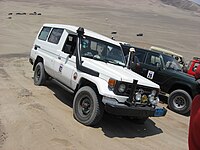
This is the 76 series gxl wagen. Its a weapon hey. a truly aussie inspired bush bus. love it.
The 32-valve V8 puts out a not too shabby 151kW at 3400rpm and peak torque of 430Nm at 1200rpm. Pulling and climbing are what this vehicle does best! new 4.5 litre V8 turbo-diesel, single turbo the 200 series gets twin.
View images in separate windows for full resolution:

79 Series

76 Series














HISTORY
The Toyota FJ70 is the model designation for a Toyota Land Cruiser made from 1984 until present day. In 1984/1985, Toyota introduced an entirely new design to replace the aging and now 25 year old 40 series Land Cruiser. What Toyota came up with was a most appropriate replacement. Although completely new in styling, every off road positive aspect of the original 40 series was retained. The all new 70 series was introduced.
1984 - 1999: The 70 / 75 series [Toyota Land Cruiser] also known as Toyota Prado and Toyota Land Cruiser 2 in most parts of the world, took over from the 40 / 45 series of workhorse four wheel drives in 1984. The styling maintained a family resemblance to the 40 / 45 series but became more angular. The 70 / 71 series is the short wheel base (SWB), the 73 / 74 is the medium wheel base (MWB) and the 75 series is the long wheel base (LWB). The latter comes as cab-chassis/utility with a "panelled" tray, and "troop carrier" hard-top (HT).
2000-present: In 2000, the pick-up version was designated the 79 series and the Troop Carrier became the 78 series. The principal changes were - coil sprung live axle in front instead of leaf sprung, redesigned steering wheel, redesigned front indicators and, in the cab-chassis, a longer wheel base which increased the rear storage capacity.
2007: The updated 70 series began production in January for market release in late February / early March 2007. Changes involve minor frontal design adjustments which incorporate the headlamps into the front profile of the vehicle due to the chassis rails being moved outwards to accommodate the new V8 turbo-diesel engine - a dramatic change nonetheless considering the exposed lamps and wheel arches have been a signature design component of the 70 series from day one. Only one engine is now on offer - a 4.5L V8 turbo diesel 1VD-FTV, while the cab-chassis / tray back (LWB) and Troop Carrier (LWB) bodies will remain; new to the range is the 76 series, a four door MWB wagon variant.
The suspension, interior and basic layout of these models are nearly identical to the more famous longer wheelbase 75 series Land Cruisers, but the frame and body is much shorter. This allows the Land Cruiser to be more nimble off road. This model was popular as a personal off road transport, but because the Land Cruiser was marketed almost exclusively as a commercial and government vehicle and because these were never sold in the largest auto market in the world, the US, few were built, compared to other Land Cruiser models.
However, these models were sold all over the world, except North America, in the 1980s and early 1990s. They can be found in Japan, Asia, Africa, New Zealand and South America. The short wheelbase models are not quite as common in Australia, but they are very popular in the homeland of Japan, where compactness and rugged 4X4 are a welcome combination.
Square-bodied Land Cruiser utility 4x4 two door with steel doors and top, slanted windshield. The front-clip styling remains much like that of the 40 Series. The grille can be mesh or can consist of three horizontal bars.
Both have three additional horizontal slots in a single line under the grille. Front turn signals are square with triangular white lens elements underneath, and are affixed to the vertical edge of the front clip above the fenders and just outboard of each headlight. The top can be hard or soft. The doors are hard, with roll-up windows. Taillights are long, vertical rectangles inset low into the rear bodywork. Rear doors are paired swing-out 'barn doors'. Windshields of some military versions will fold atop hood. Available in many forms, including , a four-door semi-long (J77V → J76V), a pickup (J75P → J79P), and long wheelbase utility wagon (J75V → J77V / J78V).
Today, few short wheelbase 70 series can be purchased new. Some are still in production today in some select South American countries and possibly still in the Japanese homeland.





0 comments:
Post a Comment